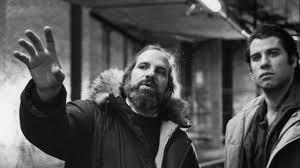Brian DePalma (1976-1983)

Brian De Palma’s early career represents an era of fearless experimentation, technical brilliance, and divisive storytelling. Emerging as one of the most controversial and audacious directors of his time, De Palma often polarized critics and audiences alike with his ability to blend highbrow artistry with lurid, exploitative themes. His work during these years is distinguished by his love for Hitchcockian suspense, his mastery of visual storytelling, and his willingness to provoke. Whether through his expert use of split screens, extended tracking shots, or elaborate set pieces, De Palma created cinematic moments that are as visually stunning as they are narratively charged.
Carrie (1976) De Palma’s ascent to mainstream recognition began with an adaptation of Stephen King’s debut novel Carrie, the story of a painfully shy teenager with telekinetic powers who endures relentless bullying at school and torment from her fanatically religious mother. Sissy Spacek’s haunting performance brings a heartbreaking vulnerability to the role, while Piper Laurie’s portrayal of Carrie’s mother adds a chilling intensity that balances the supernatural elements. De Palma’s direction is a masterclass in tension and visual storytelling. The film’s iconic prom scene, where Carrie exacts vengeance on her tormentors, is a tour de force of suspense, building to a crescendo of violence and chaos. The use of split screens, slow motion, and dramatic lighting amplifies the emotional impact, creating a sequence that remains one of the most memorable in horror cinema. The film’s emotional resonance has ensured its legacy, not just as a horror movie but as a poignant exploration of alienation, repression, and the devastating consequences of cruelty.
The Fury (1978) De Palma revisited the theme of psychic powers with The Fury, a thriller that blends supernatural elements with political intrigue. The film follows Peter Sandza (Kirk Douglas) as he tries to rescue his psychic son from a shadowy government agency intent on exploiting his abilities. Amy Irving’s portrayal of a young woman with similar psychic powers adds another layer to the narrative, which is rich in intrigue but occasionally convoluted. That said, what The Fury lacks in narrative cohesion, it makes up for in style and spectacle. De Palma delivers several visually arresting set pieces, including a suspenseful tilt-a-wheel sequence and a climactic explosion rendered in slow-motion glory. This final scene, of a character obliterated in a cascade of debris, is quintessential De Palma—bold, excessive, and unforgettable. While The Fury doesn’t reach the emotional heights of Carrie, it remains a compelling showcase of De Palma’s technical prowess.
Dressed to Kill (1980) With Dressed to Kill, De Palma delivered one of his most controversial and Hitchcockian works. A psychosexual thriller that draws heavily from Psycho, the film weaves a twisted tale of murder, deception, and sexual intrigue. Angie Dickinson stars as a woman whose illicit affair leads to her brutal murder, while Nancy Allen and Michael Caine provide strong supporting performances. The film’s visual language is meticulously crafted, with De Palma employing long, unbroken takes, split-diopter shots, and an atmospheric score by Pino Donaggio to build tension. The film’s standout sequence—a silent, voyeuristic pursuit through a museum—demonstrates De Palma’s mastery of visual storytelling, turning a seemingly mundane setting into a stage for psychological drama. Celebrated for its craftsmanship and its audacious exploration of voyeurism and desire, Dressed to Kill stands as a quintessential example of De Palma’s ability to blend beauty with brutality.
Blow Out (1981) Blow Out is De Palma’s magnum opus; a haunting political thriller that combines masterful storytelling with profound emotional weight. John Travolta stars as Jack Terry, a sound technician who inadvertently records evidence of a political assassination. As he pieces together the truth, Jack finds himself entangled in a web of corruption, deceit, and tragedy. De Palma’s direction is at its most assured, with the film showcasing his ability to use sound and imagery as narrative tools. The opening sequence, as Jack records ambient noise for a low-budget horror film, is both a sly commentary on filmmaking and a prelude to the film’s central mystery. The film’s climax, set against a cacophony of fireworks, is devastating in its emotional impact, underscoring the futility of Jack’s quest for justice. Though a box-office disappointment, Blow Out has since been re-evaluated as one of De Palma’s finest works—a chilling meditation on paranoia, power, and the sacrifices made in pursuit of the truth, solidifying De Palma’s place as a master of suspense.
Scarface (1983) De Palma concluded this era with Scarface, a lavish and violent reimagining of the 1932 gangster classic. Written by Oliver Stone and starring Al Pacino as Tony Montana, the film chronicles Tony’s rise and fall within Miami’s cocaine empire. Scarface is a maximalist spectacle, with De Palma’s direction embracing excess at every turn. The film’s visual style is unapologetically gaudy, reflecting Tony’s insatiable greed and ambition. Pacino’s performance is larger than life, capturing both Tony’s charisma and his unrelenting brutality. Defiantly vulgar and overblown, it has become a cultural touchstone, celebrated for its quotable dialogue, iconic imagery, and operatic scope. Despite its flaws—including a tendency to veer into melodrama—Scarface remains a fascinating exploration of the American Dream as a tale of hubris and moral decay. Its enduring popularity speaks to De Palma’s ability to create films that resonate far beyond their initial reception.
Overall Appraisal A testament to Brian DePalma’s status as one of the most daring and innovative filmmakers of his generation, these films are defined by their technical ingenuity, narrative boldness, and willingness to provoke. From the intimate horror of Carrie to the operatic excess of Scarface, De Palma demonstrates a remarkable ability to craft stories that are both visually arresting and thematically rich. While his work is not without its flaws—including its reliance on pastiche and its occasional lapses into excess—De Palma’s films remain compelling for their audacity and craftsmanship. This period represents the peak of his creative powers, a time when he was unafraid to take risks and push the boundaries of cinematic storytelling.
